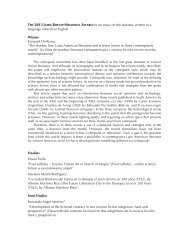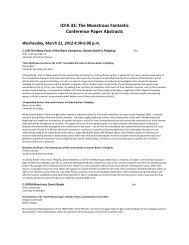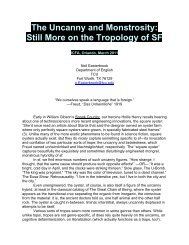5. (F) Wondrous Bodies of the Gendered Monstrum in Fairy Tales and Fantasy Captiva BChair: Cristina BacchilegaUniversity of Hawai’i-Mānoa<strong>Monstrous</strong> Masculinity in Fairy TalesJeana JorgensenIndiana UniversityManhood and masculinity have been analyzed less (and only in recent years) than femininity, due in large part to the invisibility of masculinityas the norm in patriarchal cultures (discussed in Gardiner). In fairy-tale scholarship, too, masculinity has often been treated as an after-thought,something to discuss once all the interesting things have been said about women’s roles in fairy tales, or something to present in contrast towomen’s bodies. In this paper, I examine how masculinity is constructed in fairy tales as both normal and normalizing, whereby the monstrosityof many male characters’ actions is obscured by the fantastic conventions of the fairy-tale genre. Empirical analysis of men’s bodies in fairytales in my dissertation has shown that men are overwhelmingly described in terms of their strength, size, and age, compared to an emphasison beauty and appearance for women (see also Baker-Sperry and Grauerholz). However, even where fairy-tale men are acknowledged to bemonstrous, as with the villain Bluebeard, the focus is shifted away from the monstrosity of their actions, and onto other aspects of thenarrative. In “Bluebeard,” both critics of the tale (such as Bettelheim) and writers of certain versions of the tale (especially Perrault) shift thefocus to judging the heroine’s actions, namely her curiosity in violating the interdiction to open the forbidden chamber, resulting in whatCristina Bacchilega calls “an explicit condemnation of the heroine’s curiosity, but total silence on the ethics of the husband’s serial murders”(Postmodern Fairy Tales 106). In many versions of “Bluebeard” and the accompanying criticism, there are thus both textual and metatextualstrategies for displacing the husband’s transgressive behavior onto the wife, downplaying the threatening consequences of his masculinity.However, the phenomenon of shifting the focus away from male bodies and male power also extends to tales with male characters that are lessobviously monstrous. I will discuss examples of both obvious and subtle constructions of the monstrous masculine, employing feminist andqueer theory to disentangle the question of how monstrosity is narrated onto bodies in fairy tales and fantasy.Gracious Corporeality: Carol Emshwiller’s Feminist Caresses of Heteropatriarchal MonstrosityIda YoshinagaUniversity of Hawai’i-MānoaI will examine experimental author Carol Emshwiller’s stories, including “<strong>The</strong> Library,” “Boys,” “Abominable,” and “All of Us Can Almost…,” toenumerate her clear-eyed, cold, yet compassionate methodology for illustrating gender relations through spiritual, if cagily clever, storytelling.Emshwiller’s narrative style skirts around—even eviscerates—generic boundaries separating sf, horror, and fantasy. Her postmodern feministapproach to story conventions of the fantastic, transports stock characters of genre fiction—generals, thieves, angels, and superheroes—intofamiliar diegetic premises—creature confronting maker, pacifist defying soldier, stalker hunting prey—but presents these tales with an avantgardewink. Emshwiller’s key surrealistic technique is an allegorical depiction of corporeality, marked by distanced, vague narration that resiststhe linear, literal, totalizing descriptive tricks of realist writing. Her cartoon-like narration deploys satire to draw reader interest towardsmonstrous bodies produced by heteropatriarchal societies and towards violences generated on/by/beyond such bodies. But it sketches thesemonstrous figures (and their harms) in Zen-like dotted lines, shielding the reader’s body from absorbing the spiritual damage of entering intotextual modes of violence generated by masculinist, militaristic story genres. Emshwiller’s sexism-corrective plots place the most grotesquemale figures, about to commit the cruelest masculinist actions, into situations reducing their physical power, such as being dwarfed withinnatural landscapes (harsh snowscapes/mountaintops), or into corporeally vulnerable positions alongside stronger females (nurturers, thinkers,or hags protecting the men whose strength fails), thus re-contextualizing male embodiment as small, f(l)ailing, ultimately, ridiculous. LestEmshwiller’s light touch mislead the reader into minimizing the weight of issues at hand, her narratives offer as their prime target, the brutalityengendered upon male and female bodies by military-industrial complexes and patriarchal orders. If a tale’s narration reveals its grandworldview, then Emshwiller’s Story Goddess is in turns gracious, knowing, withholding, and merciless.Ambiguous Monstrosity in Kelly Link’s “<strong>The</strong> Cinderella Game”Christy WilliamsHawai’i Pacific UniversityIn the author’s note to her short story “<strong>The</strong> Cinderella Game,” Kelly Link says that “everyone in it could be a villain. It just depends on whichfairy tale you think you’re reading” (200). <strong>The</strong> ambiguity of the villain is created in part by slippage between the concepts of villain and monster.<strong>The</strong> two are interchangeable in this story. Every character is painted with monstrous imagery, invoking werewolves and zombies, and bothchildren play at being evil in their game of “Cinderella.” Peter and his younger stepsister Darcy argue over who gets to be Cinderella and who isthe evil stepsister. Peter claims the role of Cinderella and immediately turns her “evil,” transforming the traditional heroine into another villain.Allowing Cinderella to be played by a boy—thereby not matching character gender to biological sex—completely changes her role in the storyof “Cinderella,” and the fairy tale falls apart. <strong>The</strong> “new, improved version” of “Cinderella” Peter imagines contains no heroes, princes, normagical helpers (191). Undoing the gender-sex pairing allows the story to unravel. Disrupting the male/female binary also disrupts the good/evilone. And once everyone can be “evil,” the fairy-tale conventions break down, and the game the children play slips into the horrific. My paperwill examine how the fairy-tale conventions invoked in Link’s “<strong>The</strong> Cinderella Game” are disrupted and transformed by questioning both theconcepts of gender and evil, and by suggesting that one is constructed as monstrous by others. I argue that the slippage between villain andmonster is an effect from blending fairy-tale and horror genres and referencing monstrous fairy-tale villains. As such, villain becomes arelational term: who the villain is depends on from whose point of view one is seeing the story.
7. (IF) Alien and Indigenous Encounters in the Americas Vista BChair: Andrew AberdeinFlorida Institute of TechnologyDictatorship, Trauma and the <strong>Monstrous</strong> <strong>Fantastic</strong> In the Brazilian AmazonM. Elizabeth GinwayUniversity of FloridaIn this paper I will examine the monstrous fantastic in three science fiction and fantasy texts set in the Amazon. I argue that the regionrepresents the country’s collective unconscious, placing the trauma of the dictatorship and forced economic development far from Brazil’s mainpopulation centers, in a metaphorical “heart of darkness.” As works of genre literature, two of the three novels, Marcio Souza’s 1983 <strong>The</strong> Orderof the Day and Ivanir Calado’s Mãe do sonho [Mother of Dreams] (1990) have conventional narrative closure and resolution. <strong>The</strong> third, Robertode Sousa Causo’s O Par [<strong>The</strong> Partner] (2001) is a more open-ended text suggestive of the ambivalent discourse of trauma studies. While theseworks of Brazilian science fiction and fantasy offer a powerful means of conveying trauma caused by monstrous or alien life, they also exploreencounters among indigenous and Western cultures and a new spectrum of identity and gender roles, both suggestive of the unsettling natureof trauma. In most cases, the images of territorial and bodily invasion symbolize the trauma of modernization, which remains long after themonsters have disappeared.Second Contact: <strong>The</strong> First Contact Story in Latin American Science FictionRachel Haywood FerreiraIowa State University<strong>The</strong> historical first contact between the explorers and conquistadors from Spain or Portugal and the original inhabitants of Central and SouthAmerica is the subtext for a wide range of science-fictional works written in Latin America. Indeed Latin American stories of first contact mightbetter be described as stories of second contact due to the degree to which the original historical circumstances and the colonial legacy informcontent and perspective. This paper explores the effects of the Columbian first contact and its aftermath on Latin American works such as “<strong>The</strong>Falsifier” (José Adolph, Peru, 1971) and “When Pilate Said No” (Hugo Correa, Chile, c.1960) (both of these texts have been translated intoEnglish in the Cosmos Latinos anthology).*******Thursday, March 22, 2012 8:30-10:00 a.m.8. (IF/VPA/FTV) Consumption and Flesh in the Japanese <strong>Fantastic</strong> PineChair: Hiroko ChibaDePauw UniversityWeaponized Flesh: <strong>The</strong> Echoes of World War II in Akira and Mother 3Concetta BommaritoUniversity of Central Florida<strong>The</strong> cultural scars of fascism in Japan have not healed in part because there is still a cultural taboo against discussing World War II. Censorshipduring and after US occupation made direct discussion of the war near-impossible, and cultural taboos about the war prevent changes to thenow self-censorship regulations. Instead, the Japanese have had to devise a coded system to understand a history that is not taught to them inschools or public discourses. Serious criticism of the technology-driven military industrial complex that lead to Japan’s fascist regime is almostentirely found in popular culture because of these taboos. This paper will seek to demonstrate the ways in which critiques of EmperorHirohito’s indoctrination of young soldiers have overlapped with Japan’s technology driven militarism in Katsuhiro Otomo’s manga Akira andShigesato Itoi’s video game Mother 3. Akira refuses any optimism for the use of technology to rebuild the country and challenges the notion ofthe Japanese as victims of corruption. Otomo’s characters do not thrive, but are time and again made to fight against their oppressors only toface disfigurement, death, and an uncertain future. In Mother 3, Itoi shows a more cautious optimism in which characters face down adversityas a trial rather than a continuous struggle. Thought technology disfigures and kills them, the characters of Mother 3 ultimately embracetechnology as their means of existence, becoming self-aware as characters in a game and passing their experiences to the player in hopes ofsharing a message of compassion. <strong>The</strong>se two works will be analyzed to demonstrate the progression of attitudes during and after thetechnology-driven economic boom of the 90s and will be viewed through Takashi Murakami’s Superflat movement and the Otaku (dedicatedpopular culture fan) as Hiroki Azuma’s database animals.
- Page 6 and 7: Fantastic Suicide: Reading the Unca
- Page 8: Viral Posthumanism: Boundaries and
- Page 11 and 12: The Concept of Soul Divisibility in
- Page 13 and 14: Thursday, March 22, 2012 10:30 a.m.
- Page 15 and 16: 21. (CYA) Terrifying Futures: Post-
- Page 17 and 18: 23. (FTV/H) Now I’m Feelin’ Zom
- Page 19 and 20: Fight Club: Amalgam of the Horrific
- Page 21 and 22: Taking the Monsters out of the Clos
- Page 23 and 24: Kaspar J. SaxenaIndependent Scholar
- Page 25 and 26: 44. (CYA) The Monstrosity of Teenag
- Page 27 and 28: 46. (FTV/SF) Monstrous Spin-offs: T
- Page 29 and 30: 49. (F) Aspects of Miéville Captiv
- Page 31 and 32: 53. (SF) War and Crisis in 1940s an
- Page 33 and 34: Abuse of Power: An Evolutionary Res
- Page 35 and 36: Disappearing Natives: The Colonized
- Page 37 and 38: 60. (H/IF) Ancient and Medieval Mon
- Page 39 and 40: 62. (F) The Works of Tolkien Captiv
- Page 41 and 42: 67. (SF) Imperial and Postcolonial
- Page 43 and 44: Beheading the Gorgon: Beautifying C
- Page 45 and 46: 71. (VPA) Monstrous Music MagnoliaC
- Page 47 and 48: 73. (F/IF) Portraying New Worlds Ca
- Page 49 and 50: Friday, March 23, 2012 2:45-3:45 pm
- Page 51 and 52: 81. (FTV) Those Damn Dirty Apes! Cy
- Page 53 and 54:
Friday, March 23, 2012 4:00-5:30 pm
- Page 55 and 56:
92. (F) Leaving the Demonized Other
- Page 57 and 58:
94. (FTV/CYA) Monstrosity and Devia
- Page 59 and 60:
of cannibalism, ghostly seduction i
- Page 61 and 62:
Saturday March 24, 2012 8:30-10:00
- Page 63 and 64:
104. (CYA) Classic Monsters, Reinte
- Page 65 and 66:
107. (VPA) Monstrous Gaming Bodies
- Page 67 and 68:
who challenge the order that the Br
- Page 69 and 70:
Reading Between the Times: A Critic
- Page 71 and 72:
117. (FTV) Monsters and Superheroes
- Page 73 and 74:
119. (IF/H/PCS) International Mash-
- Page 75 and 76:
Focusing on Stoker's Dracula as one
- Page 77 and 78:
Florida Atlantic UniversitySheri S.
- Page 79 and 80:
Simmons CollegeIn the spate of rece
- Page 81 and 82:
Independent ScholarKing’s story
- Page 83 and 84:
modernity opens up for every indivi
- Page 85 and 86:
Saturday March 24, 2012 4:00-5:30 p
- Page 87 and 88:
141. (FTV) Monstrous Masculinity Cy
- Page 89 and 90:
ultimately make peace with her mons
- Page 91 and 92:
where the almost-human sentient zom





